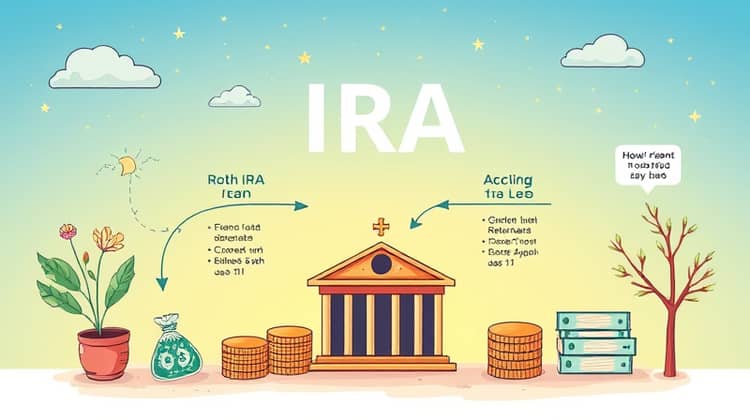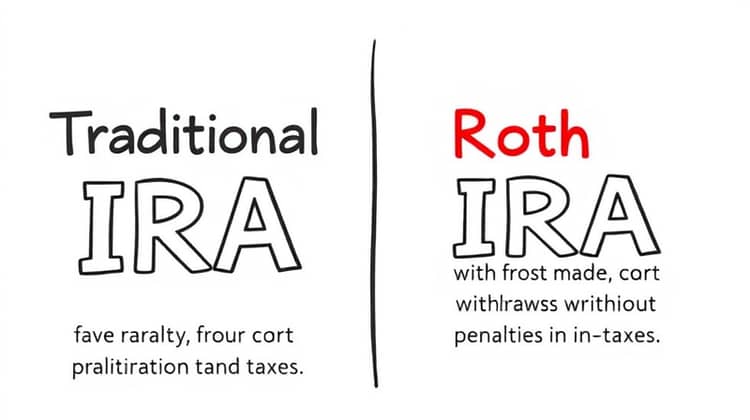When it comes to retirement savings, the Individual Retirement Account (IRA) and its counterpart, the Roth IRA, are two popular options that many individuals consider. Both accounts offer tax advantages, but they operate differently and cater to different financial situations and goals.
This article will explore the key differences between these two types of IRAs, helping you to determine which one might be the best fit for your retirement planning needs.
Understanding the Basics

An Individual Retirement Account (IRA) is a tax-advantaged savings account designed to help you save for retirement. Contributions to a traditional IRA may be tax-deductible, and the funds grow tax-deferred until you withdraw them during retirement. On the other hand, a Roth IRA allows you to contribute after-tax dollars, meaning your withdrawals in retirement will be tax-free.
Both accounts have unique features regarding eligibility, tax treatment, and withdrawal rules. Understanding these basics is crucial before deciding which plan aligns with your long-term financial strategy.
- IRA contributions may be tax-deductible depending on income and other factors.
- Roth IRAs offer tax-free growth and tax-free withdrawals in retirement.
- Traditional IRA allows you to reduce taxable income in the year you contribute.
Considering these factors, it's essential to examine your current financial situation and future expectations to choose the best retirement account.
Tax Benefits

Tax advantages are one of the primary reasons individuals open IRAs in the first place. Both traditional and Roth IRAs provide ways to save for retirement while reducing your overall tax burden in different ways. Understanding how these accounts work in terms of taxes can significantly impact your decision.
For instance, contributions to a traditional IRA may reduce your taxable income for the year the contributions are made, leading to lower immediate tax liabilities. However, withdrawals during retirement will be taxed as income.
Traditional IRA Tax Benefits
The traditional IRA is characterized by its immediate tax benefits, allowing individuals to deduct contributions from their taxable income during the year the contribution is made. As a result, this can provide significant tax savings, especially for individuals in higher tax brackets.
Additionally, because the investments within the IRA grow tax-deferred, you will not owe taxes on any income generated (interest, dividends, capital gains) within the account until you start making withdrawals.
- Tax-deductible contributions can lower your taxable income in the present year.
- Growth within the account is tax-deferred until withdrawal.
This tax-deferral can lead to significant accumulation of wealth over time, making traditional IRAs an attractive choice for many savers.
Roth IRA Tax Benefits
Unlike traditional IRAs, contributions to a Roth IRA are made with after-tax dollars. As a result, the main tax benefit comes when you withdraw funds during retirement, as these withdrawals are entirely tax-free. This can be particularly advantageous for those who expect to be in a higher tax bracket when retiring.
The tax-free growth and withdrawals can also provide a hedge against future tax increases, ensuring you don't pay taxes on your investment gains.
- All qualifying withdrawals during retirement are tax-free.
- No minimum distribution requirements allow you to grow your investment longer.
The ability to withdraw contributions at any time without penalties adds to the Roth IRA's appeal, making it a flexible retirement savings option.
Contribution Limits

Both traditional and Roth IRAs have specific contribution limits set by the IRS. Understanding these limits is crucial for maximizing your retirement savings. For the tax year 2023, individuals can contribute up to $6,500 to these accounts, with an additional $1,000 allowed for those aged 50 and older, making a total of $7,500.
It’s important to note that these limits can change annually, so keeping informed about updates from the IRS is essential as you plan your retirement savings strategy.
Withdrawal Rules

Withdrawal rules differ significantly between traditional and Roth IRAs, impacting your overall retirement planning strategy. For instance, traditional IRA withdrawals are generally subject to income tax and may incur a 10% penalty if taken before the age of 59½ unless certain conditions are met.
In contrast, Roth IRAs allow contributions to be withdrawn at any time without penalties, and as long as certain conditions are met, eligible distributions of earnings can be withdrawn tax-free.
Investment Options

Both traditional and Roth IRAs provide a wide array of investment options, allowing individuals to tailor their portfolios to match their retirement goals. These options can include stocks, bonds, mutual funds, and ETFs, among others.
The flexibility to choose your investments is an essential feature offered by both types of IRAs, and can significantly affect retirement outcomes depending on the investment strategy employed.
Additionally, both accounts allow for the same investment types, and the decision between a traditional IRA and a Roth IRA shouldn't hinge solely on investment options but rather on tax implications and personal financial situations.
Which One Is Right for You?

Determining which type of IRA is appropriate for your retirement savings involves assessing your current financial status, future income expectations, and tax situation. This decision often comes down to whether you prefer tax savings now or later, and the flexibility of tax-free withdrawals.
By Age:
Your age can significantly influence your decision between a traditional IRA and a Roth IRA. Younger individuals in lower tax brackets might find a Roth IRA beneficial now, allowing them to grow their accounts and leverage tax-free withdrawals later on.
Conversely, those nearing retirement and potentially earning higher incomes might benefit from old traditional IRA tax deductions, making immediate tax savings a priority.
- Younger savers should consider Roth IRAs for long-term tax-free growth.
- Older savers may prefer traditional IRAs for immediate tax deductions.
Ultimately, your age can inform your decision and help balance short-term savings with long-term investment growth.
By Income:
Income brackets are another crucial factor in deciding between a traditional IRA and a Roth IRA. Higher-income individuals are often limited in their ability to contribute to Roth IRAs due to income limits imposed by the IRS. In contrast, traditional IRAs do not have income limits for contributions, but the ability to deduct those contributions may phase out at higher income levels.
Lower-income individuals might find the Roth IRA advantageous as its benefits will be fully available, allowing them to build tax-free wealth for retirement.
- High earners may prefer a traditional IRA for deductibility, if eligible.
- Lower earners can take full advantage of the Roth IRA’s tax-free withdrawals.
Understanding your income situation in relation to IRA options is key to maximizing your retirement planning.
Conclusion

Choosing the right retirement account between a traditional IRA and a Roth IRA is a personal decision that requires careful consideration of your current financial position, tax situation, and retirement goals. While both offer significant advantages, they cater to different financial strategies and future expectations.
Ultimately, informed and strategic planning using the right IRA can lead to a secure and comfortable retirement.














